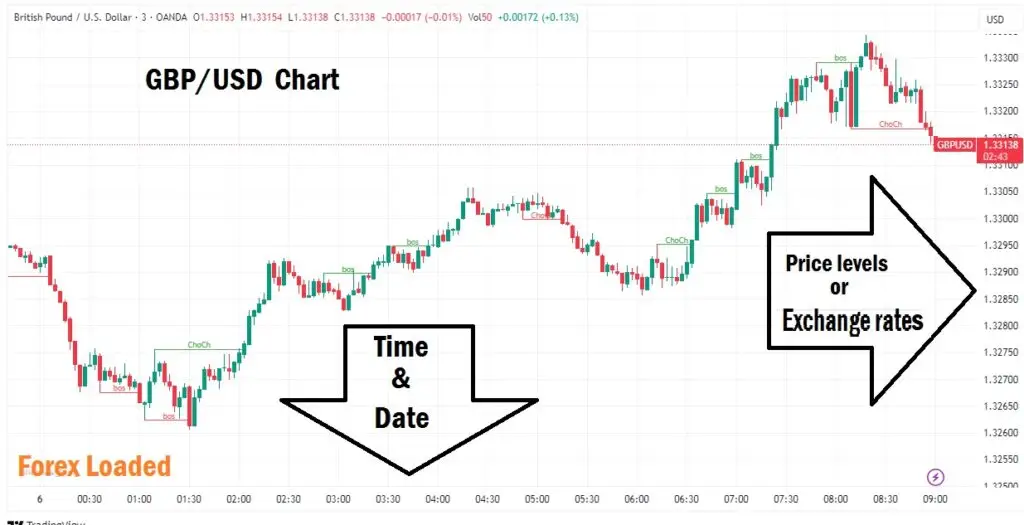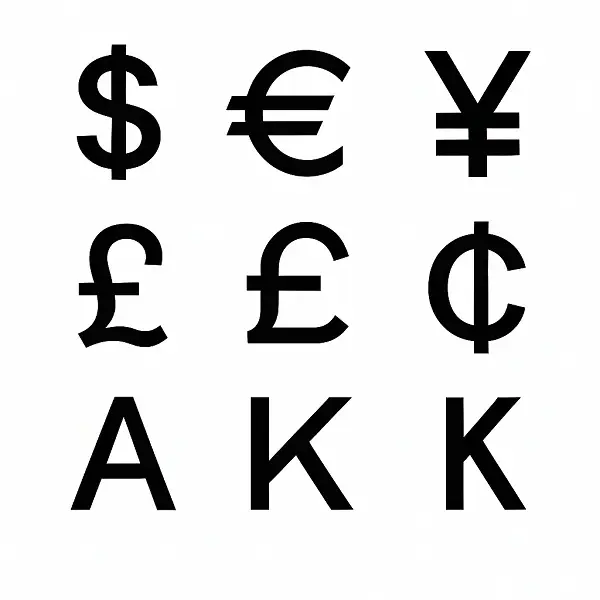Welcome to this lesson! In this module, we’ll explore how buying and selling currency pairs works in the forex market, a foundational concept every beginner must understand.
What Does It Mean to Buy and Sell Currency Pairs?
In forex trading, buying and selling currency pairs simply means you’re buying one currency while simultaneously selling another. As discussed in the previous lesson on what a currency pair is, currencies are always traded in pairs, because you’re always exchanging one currency for another.
So, when you buy one currency, you’re selling its counterpart in the pair. This concept can be a bit confusing at first. But as we dive deeper, you will understand it better.
Example: Understanding Currency Pairs
Forex pairs consist of two currencies. Example, GBP/USD (British Pound / US Dollar). In any currency pair, the first currency is the base currency, and the second is the quote currency. In many cases, the stronger currency is the base, while the relatively weaker one is the quote.
In the pair GBP/USD:
- GBP (British Pound) is the base currency.
- USD (US Dollar) is the quote currency.

When analyzing a forex chart, you’re viewing the value of one currency compared to another. For example, if the GBP/USD chart rises, the British Pound gains value against the US dollar. If it falls, the US dollar gains value against the British Pound.
How to Read a Forex Chart
A forex chart displays the real-time exchange rate between two currencies. It tells you how much of the quote currency is needed to buy one of the base currency.
Each currency pair has its own chart. The chart has rows and columns displaying different information.
- The rows of the chart display price levels.
- The Columns of the chart show time intervals.
Let’s say you’re holding GBP and want to buy USD. You’d look at the GBP/USD chart to see how many pounds you need to exchange for one dollar. Similarly, if you’re holding USD and want to buy GBP, you’d still use the same chart but interpret it in reverse.
When the chart rises, it means the base currency (GBP) is strengthening. When it falls, the quote currency (USD) is gaining strength.
Why Do Exchange Rates Fluctuate?
Exchange rates change based on market sentiment and the perceived strength of a country’s economy. When traders believe a country’s economy is strong, demand for its currency increases, driving its value up. On the other hand, if confidence in the economy falls, traders will move their funds to a stronger currency.
This ongoing shift in sentiment is what causes volatility in forex charts.
Where Do You Trade Currency Pairs?
To begin trading forex, you need access to a forex broker.
A broker is a financial intermediary that provides a trading platform to connect retail traders (like you) with major banks or liquidity providers. Think of brokers as the “small boats” that ferry your trades to the “big ships,” the large financial institutions. Without brokers, participating in the forex market would be incredibly difficult and expensive for individual traders.
In simple terms, brokers make forex trading accessible, offering tools, platforms, and connectivity from the comfort of your home.
What Is Liquidity in Forex?
Liquidity refers to the amount of activity in the market, essentially, how much money is flowing through it. A highly liquid market moves smoothly with smaller spreads, while a low-liquidity market is more volatile and riskier to trade.
Categories of Currency Pairs
There are three main categories of currency pairs in the forex market:
1. Major Pairs
These are currency pairs that include the US Dollar (USD) and are the most traded worldwide. They are highly liquid and exhibit high volatility. There are seven major pairs, all involving USD. A list of the major pairs is in the table below.
| COUNTRIES | CURRENCY PAIR | FOREX GEEK SPEAK |
| Eurozone / United State | EUR/USD | euro dollar |
| United Kingdom / United States | GBP/USD | pound dollar |
| United States / Japan | USD/JPY | dollar yen |
| United States/ Switzerland | USD/CHF | dollar swissy |
| United States / Canada | USD/CAD | dollar loonie |
| Australia / United States | AUD/USD | aussie dollar |
| New Zealand / United States | NZD/USD | kiwi dollar |
2. Cross Pairs (Crosses)
Cross-currency pairs exclude the USD but involve other major currencies like EUR, JPY, and GBP. They are moderately traded and less liquid than the majors. A list of the cross pairs is in the table below.
| COUNTRIES | CURRENCY PAIR | FOREX GEEK SPEAK |
| Eurozone / Switzerland | EUR/CHF | euro swissy |
| Eurozone / United Kingdom | EUR/GBP | euro pound |
| Eurozone / Canada | EUR/CAD | euro loonie |
| Eurozone / Australia | EUR/AUD | euro aussie |
| Eurozone / New Zealand | EUR/NZD | euro kiwi |
| Eurozone / Sweden | EUR/SEK | euro stockie |
| Eurozone / Norway | EUR/NOK | euro nockie |
| Eurozone / Japan | EUR/JPY | yuppy |
| United Kingdom / Japan | GBP/JPY | guppy |
| Switzerland / Japan | CHF/JPY | swissy yen |
| Canada / Japan | CAD/JPY | oonie yen |
| Australia / Japan | AUD/JPY | aussie yen |
| New Zealand / Japan | NZD/JPY | kiwi yen |
| United Kingdom / Switzerland | GBP/CHF | pound swissy |
| United Kingdom / Australia | GBP/AUD | pound aussie |
| United Kingdom / Canada | GBP/CAD | pound loonie |
| United Kingdom / New Zealand | GBP/NZD | pound kiwi |
Other crosses include:
| COUNTRIES | CURRENCY PAIR | FOREX GEEK SPEAK |
| New Zealand / Canada | NZD/CAD | kiwi loonie |
| New Zealand / Switzerland | NZD/CHF | kiwi swissy |
| Canada / Switzerland | CAD/CHF | loonie swissy |
| Australia / New Zealand | AUD/NZD | aussie kiwi |
| Australia / Canada | AUD/CAD | aussie loonie |
| Australia / Switzerland | AUD/CHF | aussie swissy |
3. Exotic Pairs
Exotic currency pairs consist of one major currency and one from a country with a developing or emerging economy. These pairs are less frequently traded and tend to have wider spreads and higher volatility due to lower liquidity and sensitivity to geopolitical events. A list of the exotic pairs is in the table below.
| COUNTRIES | CURRENCY PAIR | FOREX GEEK SPEAK |
| United States/ Chile | USD/CLP | dollar chil |
| United States / Poland | USD/PLN | dollar zloty |
| United States / Russia | USD/RUB | dollar ruble |
| United States / Mexico | USD/MXN | dollar mex |
| United States / Thailand | USD/THB | dollar baht |
| United States / South Africa | USD/ZAR | dollar rand |
| United States / Saudi Arabia | USD/SAR | dollar riyal |
| United States / Hong Kong | USD/HKD | |
| United States / Singapore | USD/SGD | dollar sing |
| United States / Brazil | USD/BRL | dollar real |
| United States / Nigeria | USD/NGN | dollar Naira |
What Are G10 Currencies?
The G10 currencies represent the ten most heavily traded and liquid currencies in the global forex market. These include:
- USD (US Dollar)
- EUR (Euro)
- JPY (Japanese Yen)
- GBP (British Pound)
- CHF (Swiss Franc)
- CAD (Canadian Dollar)
- AUD (Australian Dollar)
- NZD (New Zealand Dollar)
- SEK (Swedish Krona)
- NOK (Norwegian Krone)
These currencies are widely recognized and form the basis for the majority of forex transactions worldwide.
Final Thoughts for Beginners
There are about 180 legal currencies in the world and countless combinations of pairs. However, as a beginner, it’s best to focus on the major and most traded pairs. Avoid overwhelming yourself with too many choices. The simpler your forex trading approach, the more confident and skilled you’ll become over time in trading.
In the next lesson, we will look into market size and liquidity.









